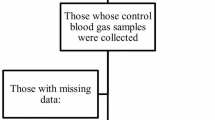Abstract
The objective of the study was to investigate the effects of adaptive support ventilation (ASV) and synchronized intermittent mandatory ventilation (SIMV) on peripheral circulation of chronic obstructive pulmonary disease (COPD) patients with respiratory failure. 86 COPD patients with respiratory failure were recruited in this study. Self-control method was used to compare the effect of ASV and SIMV on the parameters of ventilation machine, heart rate, blood pressure, central venous pressure (CVP), and blood gas markers. When the patients in ASV and SIMV groups were compared, respiratory rate, tidal volume, and peak airway pressure (PIP) showed significant difference. When minute ventilation (MV) was compared, no significant difference was shown. When peripheral circulation parameters were compared, peripheral circulation heart rate, SBP, DBP, and CVP showed significant difference. Compared with SIMV group, PaO2, pH, and SaO2 values were remarkably increased (P < 0.01) while no significant difference was found for partial pressure of carbon dioxide (pCO2) when two groups were compared. In conclusion, when mechanical ventilation was used in COPD patients with respiratory failure, ASV can significantly improve clinical outcomes.
Similar content being viewed by others
References
Antonelli, M., Azoulay, E., Bonten, M., Chastre, J., Citerio, G., Conti, G., et al. (2009). Year in review in intensive care medicine, 2008: II. Experimental, acute respiratory failure and ARDS, mechanical ventilation and endotracheal intubation. Intensive Care Medicine, 35(2), 215–231. doi:10.1007/s00134-008-1380-5.
Sulzer, C. F., Chiolero, R., Chassot, P. G., Mueller, X. M., & Revelly, J. P. (2001). Adaptive support ventilation for fast tracheal extubation after cardiac surgery: A randomized controlled study. Anesthesiology, 95(6), 1339–1345.
Petter, A. H., Chiolero, R. L., Cassina, T., Chassot, P. G., Muller, X. M., & Revelly, J. P. (2003). Automatic “respirator/weaning” with adaptive support ventilation: The effect on duration of endotracheal intubation and patient management. Anesthesia and Analgesia, 97(6), 1743–1750.
Tassaux, D., Dalmas, E., Gratadour, P., & Jolliet, P. (2002). Patient-ventilator interactions during partial ventilatory support: A preliminary study comparing the effects of adaptive support ventilation with synchronized intermittent mandatory ventilation plus inspiratory pressure support. Critical Care Medicine, 30(4), 801–807.
Dongelmans, D. A., Veelo, D. P., Paulus, F., de Mol, B. A., Korevaar, J. C., Kudoga, A., et al. (2009). Weaning automation with adaptive support ventilation: A randomized controlled trial in cardiothoracic surgery patients. Anesthesia and Analgesia, 108(2), 565–571. doi:10.1213/ane.0b013e318190c49f.
Gruber, P. C., Gomersall, C. D., Leung, P., Joynt, G. M., Ng, S. K., Ho, K. M., et al. (2008). Randomized controlled trial comparing adaptive-support ventilation with pressure-regulated volume-controlled ventilation with automode in weaning patients after cardiac surgery. Anesthesiology, 109(1), 81–87. doi:10.1097/ALN.0b013e31817881fc.
Ortiz, G., Frutos-Vivar, F., Ferguson, N. D., Esteban, A., Raymondos, K., Apezteguia, C., et al. (2010). Outcomes of patients ventilated with synchronized intermittent mandatory ventilation with pressure support: A comparative propensity score study. Chest, 137(6), 1265–1277. doi:10.1378/chest.09-2131.
Wang, Y., Sun, N., Cheng, Z., & Tong, L. (2014). Optimal time to use low molecular weight heparin on prethrombotic state of rat chronic obstructive pulmonary disease model. Chinese Medical Journal, 127(3), 518–521.
Breteler, K. B., Rentenaar, R. J., Verkaart, G., & Sturm, P. D. (2011). Performance and clinical significance of direct antimicrobial susceptibility testing on urine from hospitalized patients. Scandinavian Journal of Infectious Diseases, 43(10), 771–776. doi:10.3109/00365548.2011.588609.
Shefali-Patel, D., Murthy, V., Hannam, S., Lee, S., Rafferty, G. F., & Greenough, A. (2012). Randomised weaning trial comparing assist control to pressure support ventilation. Archives of Disease in Childhood. Fetal and Neonatal Edition, 97(6), F429–F433. doi:10.1136/archdischild-2011-300974.
Azim, H. A, Jr, de Azambuja, E., Colozza, M., Bines, J., & Piccart, M. J. (2011). Long-term toxic effects of adjuvant chemotherapy in breast cancer. Annals of oncology: Official Journal of the European Society for Medical Oncology/ESMO, 22(9), 1939–1947. doi:10.1093/annonc/mdq683.
Oki, Y., McLaughlin, P., Pro, B., Hagemeister, F. B., Bleyer, A., Loyer, E., et al. (2005). Phase II study of oxaliplatin in patients with recurrent or refractory non-Hodgkin lymphoma. Cancer, 104(4), 781–787. doi:10.1002/cncr.21219.
Pro, B., Younes, A., Albitar, M., Dang, N. H., Samaniego, F., Romaguera, J., et al. (2004). Thalidomide for patients with recurrent lymphoma. Cancer, 100(6), 1186–1189. doi:10.1002/cncr.20070.
Terblanche, M., Kruger, P., di Gangi, S., Gearay, S., Gilfeather, L., Ferguson, N. D., et al. (2012). Risk factors for acute organ failure in intensive care unit patients who receive respiratory support in the absence of non-respiratory organ failure: An international prospective cohort study. Critical Care, 16(2), R61. doi:10.1186/cc11306.
Mauri, T., Bellani, G., Grasselli, G., Confalonieri, A., Rona, R., Patroniti, N., et al. (2013). Patient-ventilator interaction in ARDS patients with extremely low compliance undergoing ECMO: A novel approach based on diaphragm electrical activity. Intensive Care Medicine, 39(2), 282–291. doi:10.1007/s00134-012-2755-1.
Xu, W., Li, J. Y., Qian, S. X., Wu, H. X., Lu, H., Chen, L. J., et al. (2008). Outcome of treatment with hyper-CVAD regimen in Chinese patients with acute lymphocytic leukemia. Leukemia Research, 32(6), 930–935. doi:10.1016/j.leukres.2007.10.019.
Author information
Authors and Affiliations
Corresponding author
Rights and permissions
About this article
Cite this article
Han, L., Wang, Y., Gan, Y. et al. Effects of Adaptive Support Ventilation and Synchronized Intermittent Mandatory Ventilation on Peripheral Circulation and Blood Gas Markers of COPD Patients with Respiratory Failure. Cell Biochem Biophys 70, 481–484 (2014). https://doi.org/10.1007/s12013-014-9944-1
Published:
Issue Date:
DOI: https://doi.org/10.1007/s12013-014-9944-1




